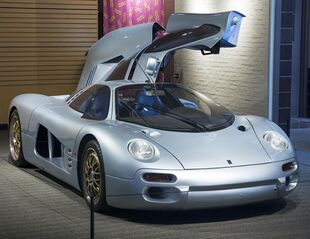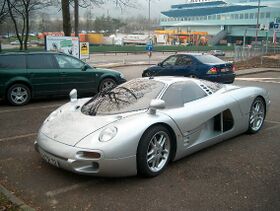Engineering:Isdera Commendatore 112i
| Isdera Commendatore 112i | |
|---|---|
 The Commendatore 112i on display at the Saratoga Auto Museum, Radwood Exhibit | |
| Overview | |
| Manufacturer | Isdera GmBH |
| Production | 1993 |
| Assembly | Leonberg, Germany |
| Designer | Eberhard Schultz |
| Body and chassis | |
| Class | Concept car (S) |
| Body style | 2-door coupé |
| Layout | Rear mid-engine, rear-wheel-drive |
| Powertrain | |
| Engine | 6.0 L Mercedes-Benz M120 V12 6.9 L Mercedes-Benz M120 V12 |
| Transmission | 6-speed manual |
| Dimensions | |
| Length | 4,622.8 mm (182.0 in) |
| Width | 1,866.9 mm (73.5 in) |
| Height | 1,031.2 mm (40.6 in) |
| uk|uk|Kerb|Curb}} weight |
|
| Chronology | |
| Predecessor | Isdera Imperator 108i |
| Successor | Isdera Commendatore GT (spiritual) |
The Isdera Commendatore 112i is a concept car conceived and developed by the German low volume automobile manufacturer Isdera. Introduced at the 1993 Frankfurt Motor Show, the 112i had a compact and sleek aerodynamic body work and was to be a successor to the Imperator 108i but the lack of financial reserves led the company into bankruptcy and only one prototype was completed.
History and development
After the Imperator 108i had ended production in 1993, Isdera was working on the development of a new model. In 1989, the first clay models took shape and development work was carried out through 1993. The new car called the Commendatore 112i was named in honour of Enzo Ferrari (Ferrari was awarded the title Commendatore II). Commendatore means Knight Commander in Italian language.
The sleek design drew inspiration from the famous Group C race cars. Eberhard Schultz, the company's founder, engaged engineers and technicians from Mercedes-Benz with approval from the company in the development of the car. There were plans to enter the car in LeMans racing which was a reason for the car's elongated styling but the idea never materialised due to Isdera's demise.[1]
The 112i had a 6-speed manual transmission which is a modified 5-speed unit from Ruf Automobile, the ABS brakes (which measured 330 mm (13 in) and the front and 305 mm (12 in) at the rear) and the suspension system were shared with the Porsche 928 while the head lamps were shared with the Porsche 968. The car has handbuilt fibreglass body work on a tubular steel spaceframe chassis and has 18-inch gold BBS alloy wheels fitted with tyres measuring 255/35 ZR18 at the front and 295/35 ZR19 at the rear. The large side intakes help cool the engine. The engine is a 6.0-litre Mercedes-Benz M120 V12 unit (first used in the Mercedes-Benz C112 and later used in the Mercedes-Benz SL600 AMG and the Pagani Zonda S).[2] It was modified to cope with the manual transmission as the original unit only came with an automatic gearbox. The modifications included an in-house developed flywheel and a Bosch ECU. The engine generated a maximum power output of 300 kW (408 PS; 402 hp) at 5,200 rpm and 580 N⋅m (428 lb⋅ft) of torque at 3,800 rpm.[3]
The 112i had advanced technologies at the time, including gull-wing doors, a gull-wing engine cover for easier access to the engine, a velocity sensitive chassis developed in collaboration with BBS and Bilstein which lowered the car by 76 mm (3 in) at high speeds, an active suspension system and an electronically controlled airbrake.[1]
The 112i retained the periscope rear-view mirror from the Imperator 108i instead of conventional side-view mirrors. It has a flat underbody for improved aerodynamics. The long tail of the car also improved airflow over it. The airbrake raises in an upright position while braking acting as a wind deflector to help slow the car down (similar to a parachute). The car had a drag coefficient of Cd=0.306 when tested in the Mercedes-Benz wind tunnel.
The interior of the car was mostly custom made and contained two tone blue and black leather upholstery along with RECARO leather sports seats. The car had wide door sills which housed the two fuel tanks. The dials and other instrumentation (excluding the steering wheel which was from OMP) were from Mercedes-Benz and the speedometer read up to 400 km/h (249 mph).[4]
Isdera planned a limited production run of the 112i like its predecessor and quoted that each car would take six months to complete. The car was not functional when it was introduced. The development of the car reportedly cost a total of €4,000,000. This combined with the ongoing economic recession in South Asia, particularly the bursting of Japan's bubble economy, pushed the company into bankruptcy shortly after the car's introduction as the major investments came from Japan. The company was then bought by Swiss investors under whom Schultz completed the car in order to make it driveable on the road.[3]
Although officially only one car was completed, Isdera completed a second subframe before its closure which was bought by an enthusiast who also purchased the original body moulds and tooling to build another unit of the 112i in collaboration with Schultz. The project was completed within a span of six years. Schultz withdrew from the project over a dispute on proposed design changes and later a re-emerging Isdera would also deny its existence. The second car is finished in a shade of white called Light Ivory and has a light grey interior with most of the switch gear sourced from Porsche. The design of the exhaust system also differs from the original as the car has a side exit exhaust exiting from beneath the doors.[5][1]
Later use
Six years later in 1999, the car was updated and renamed to "Silver Arrow C112i" by a Swiss businessman. On the exterior, the updated car had conventional side-view mirrors and had silver five-spoke Mercedes-Benz alloy wheels instead of the gold BBS units. The engine was a 6.9-litre Mercedes-Benz M120 V12 unit, which generated a total of 455 kW (619 PS; 610 hp). Interestingly, there was no Isdera badging on the car and it had Mercedes-Benz badging instead. The Silver Arrow was unveiled at the 1999 Frankfurt Motor Show.[6]
The Silver Arrow was bought by Swiss businessman Albert Klöti at a price of €1,500,000. Albert kept the car for 5 years after offering it on eBay for sale for US$3,000,000 in 2005. The car failed to sell after which it was sold back again in 2016 to Isdera.[7] Isdera along with Schultz and the Isdera Classic team then restored the car back to its original form and name and made appearances at motor shows.[5] On 13 February 2021, the Isdera Commendatore 112i was sold at a RM Sotheby's auction in Paris, France for €1,113,125.[8][7][9]
Performance
The Isdera Commendatore 112i was claimed to accelerate to 100 km/h (62 mph) in 4.7 seconds and having a top speed of 341 km/h (212 mph). The Silver Arrow C112i was claimed to have a top speed of 370 km/h (230 mph) during testing.[6][9]
Other media
The Isdera Commendatore 112i was featured in the 1997 Electronic Arts racing video game Need for Speed II. The Silver Arrow C112i was featured in a short documentary on Albert Klöti.[9]
References
- ↑ Jump up to: 1.0 1.1 1.2 Golden, Connor (2020-12-17). "The 1993 Isdera Commendatore 112i Is the Mid-Engine V-12 Supercar Time Forgot". MotorTrend. https://www.motortrend.com/news/1993-isdera-commendatore-112i-rm-sothebys-auction/.
- ↑ Sergeev, Angel (2021-10-07). "Isdera Commendatore 112i Sends Need For Speed II Vibes From Villa d'Este". Motor1. https://www.motor1.com/news/539044/isdera-commendatore-112i-villa-video/.
- ↑ Jump up to: 3.0 3.1 Potts, Greg (2021-02-01). "You can now own the world’s only Isdera Commendatore 112i". Top Gear. https://www.topgear.com/car-news/retro/you-can-now-own-worlds-only-isdera-commendatore-112i.
- ↑ "This is the World’s First and Only Isdera Commendatore 112i Supercar". TechEBlog. 2020-12-17. https://www.techeblog.com/isdera-commendator-112i-supercar/.
- ↑ Jump up to: 5.0 5.1 Kierse, Matthias (2019-09-05). "ISDERA COMMENDATORE 112I". Secret Classes. https://www.secret-classics.com/en/isdera-commendatore-112i-2/.
- ↑ Jump up to: 6.0 6.1 "1993 Isdera Commendatore 112i; 1999 Isdera Silver Arrow C112i;". FanMercedesBenz. 1 February 2015. Archived from the original on 2020-05-09. https://web.archive.org/web/20200509113500/https://www.fanmercedesbenz.com/1993-isdera-commendatore-112i-1999-isdera-silver-arrow-c112i/.
- ↑ Jump up to: 7.0 7.1 "1993 Isdera Commendatore 112i RM Sotheby's".
- ↑ "1999 Isdera Commendatore 112i".
- ↑ Jump up to: 9.0 9.1 9.2 Petrány, Máté (26 October 2018). "Internet: The New McLaren Speedtail Looks Like 1993". Road & Track.
 |






